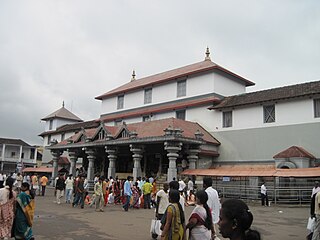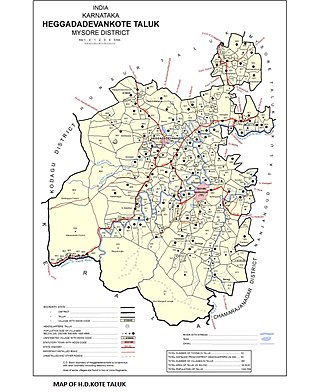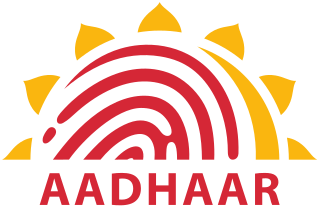Interactive voice response (IVR) is a technology that allows telephone users to interact with a computer-operated telephone system through the use of voice and DTMF tones input with a keypad. In telephony, IVR allows customers to interact with a company's host system via a telephone keypad or by speech recognition, after which services can be inquired about through the IVR dialogue. IVR systems can respond with pre-recorded or dynamically generated audio to further direct users on how to proceed. IVR systems deployed in the network are sized to handle large call volumes and also used for outbound calling as IVR systems are more intelligent than many predictive dialer systems.

An identity document is a document proving a person's identity.

Nandan Mohanrao Nilekani is an Indian entrepreneur. He co-founded Infosys and is the non-executive chairman of Infosys replacing R Seshasayee and Ravi Venkatesan, who were the co-chairs of the board, on 24 August 2017. After the exit of Vishal Sikka, Nilekani was appointed as non-executive chairman of the board effective 24 August 2017. He was the chairman of the Unique Identification Authority of India (UIDAI). After a successful career at Infosys, he headed the Government of India's technology committee, TAGUP. He is a member of Indian National Congress but not active in politics as of 2019.
A national identification number, national identity number, or national insurance number or JMBG/EMBG is used by the governments of many countries as a means of tracking their citizens, permanent residents, and temporary residents for the purposes of work, taxation, government benefits, health care, and other governmentally-related functions.

Dharmasthala is an Indian temple town on the banks of the Nethravathi River in the taluk of Belthangady of the Dakshina Kannada district in Karnataka, India.

Bangalore or Bengaluru, the capital city of the South Indian state of Karnataka, India. The economy of Bengaluru contributes over 43.65% to the economy of the State of Karnataka, accounting for 98% of the Software Exports of the State.

The National Database & Registration Authority (NADRA) is an independent and autonomous agency under the control of the Interior Secretary of Pakistan that regulates Government Databases and statistically manages the sensitive registration database of all the National Citizens of Pakistan. Lieutenant General Muhammad Munir Afsar serves as Chairman of National Database and Registration Authority (NADRA) Pakistan.

Bhoomi is a project jointly funded by the Government of India and the Government of Karnataka to digitize the paper land records and create a software mechanism to control changes to the land registry in Karnataka. The project was designed to eliminate the long-standing problem of inefficiency and corruption in the maintenance of land records at dispersed and poorly supervised and audited block-level offices known as "taluka" offices in South India and "tehsildar" offices in North India. The project development and implementation was done by National Informatics Centre.

Karnataka is one of the highest economic growth states in India with an expected GSDP growth of 9.5% in the 2021–22 fiscal year. The total expected GSDP of Karnataka in 2022–2023 is about $240 billion. Karnataka recorded the highest growth rates in terms of GDP and per capita GDP in the last decade compared to other states. In 2008–09, the tertiary sector contributed the most to GSDP, followed by the secondary sector, and the primary sector.

Sargur, is a small town located about 80 km from the town of Chamarajanagar And a Taluk of Mysore district of Karnataka, India. H D Kote (Heggadadevanakote) is about 12 km north of Sargur. It is 55 km from the city of Mysore. Bangalore International Airport is 200 km away. To be more elaborate, Sargur is 33.8 km from Nanjangud town (Karnataka), 35.1 km from Gundlupet town (Karnataka), 137.8 km from Udagamandalam town (Ooty) Valley and 38.8 km from Hunsur town (Karnataka).
A government database collects information for various reasons, including climate monitoring, securities law compliance, geological surveys, patent applications and grants, surveillance, national security, border control, law enforcement, public health, voter registration, vehicle registration, social security, and statistics.
In 2020, 97.7% of Indians had access to the basic water and sanitation facilities. India faces challenges ranging from sourcing water for its megacities to its distribution network which is intermittent in rural areas with continuous distribution networks just beginning to emerge. Non-revenue water is a challenge.

The Slovenská národná knižnica is a modern scientific, cultural, information and educational institution that serves all citizens of Slovakia and users from abroad. Slovak National Library is conservation and depositary library of Slovakia. SNL preferably collects, professionally processes, stores, protects and makes accessible domestic and foreign Slavic documents. Funds and collections of the Slovak National Library contain 4.9 million library items, 1.7 million archive documents and thousands of museum units.

Aadhaar (Hindi: आधार, lit. 'base, foundation') is a twelve-digit unique identity number that can be obtained voluntarily by all residents of India, based on their biometrics and demographic data. The data is collected by the Unique Identification Authority of India (UIDAI), a statutory authority established in January 2016 by the Government of India, under the jurisdiction of the Ministry of Electronics and Information Technology, following the provisions of the Aadhaar (Targeted Delivery of Financial and other Subsidies, benefits and services) Act, 2016.
Turkish Identification Number is a unique personal identification number that is assigned to every citizen of Turkey.
Police IT is the flagship project of the Karnataka State Police aimed at digitizing all the processes involved in policing from basic functions like crime, law and order, maintenance, and traffic to ancillary functions like police motor transport and training; and connecting all the locations of the state police viz. police stations, circle office, sub-divisional police offices, district police offices, campus networks at COP, CID, chief office and other offices of special units. It has been brought under CCTNS now.
Biometrics refers to the automated recognition of individuals based on their biological and behavioral characteristics, not to be confused with statistical biometrics; which is used to analyse data in the biological sciences. Biometrics for the purposes of identification may involve DNA matching, facial recognition, fingerprints, retina and iris scanning, voice analysis, handwriting, gait, and even body odor.

Digital India is a campaign launched by the Government of India to make its services available to citizens electronically via improved online infrastructure and by increasing Internet connectivity. The initiative includes plans to connect rural areas with high-speed internet networks. It consists of three core components: the development of secure and stable digital infrastructure, delivering government services digitally, and universal digital literacy.
The National Register of Citizens for Assam is a registry (NRC) meant to be maintained by the Government of India for the state of Assam. It is expected to contain the names and certain relevant information for the identification of genuine Indian citizens in the state. The register for Assam was first prepared after the 1951 Census of India. Since then it was not updated until the major "updation exercise" conducted during 2013–2019, which caused numerous difficulties. In 2019, the government also declared its intention of creating such a registry for the whole of India, leading to major protests all over the country.
Unorganised Workers' Identification Number or UWIN is a proposed unique number to be issued as identity proof to unorganised workers in India.










